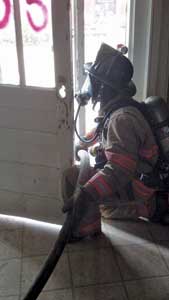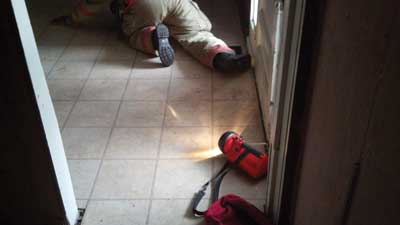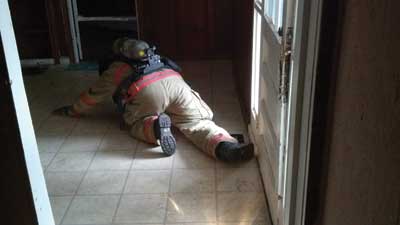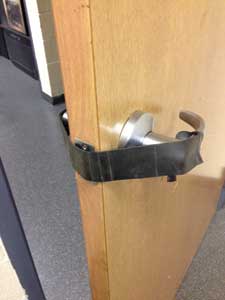BY SEAN GRAY
Recently, a cohesive group of firefighters organized a Truck Company Operations course for our department. The basics were covered: ventilation, ground ladders, search, and forcible entry/exit. Cobb County (GA) Fire and Emergency Services does not traditionally operate with engine- or truck-specific assignments. We have 29 engines and only eight ladder trucks serving a diverse suburban community. To do efficient truck work, we would need to almost double the number of ladder trucks. In the past, we used the ladder truck mostly as an aerial master stream or increased staffing on the fireground. We do not have predetermined assignments for ladder trucks, and that’s okay. Many suburban fire departments operate in a similar manner. However, the lack of focus on truck company operations, especially ventilation, was troubling to me and others, hence the creation of the Truck Academy.
Our department has no interest in becoming a large-city department. We have different buildings and different tactics than a big city. We strive to use the best tactics at the right time for the appropriate structure with the proper number of personnel. Safety is one of our primary department goals, and there is a detailed focus on tactics that may put our firefighters in danger. This is the reason roof ventilation has not been a popular choice within Cobb County. But after doing the research for the ventilation class, we learned that eight firefighters in the United States died while performing roof ventilation vs. 28 who died as a result of flashover within the past 15 years.
I began my career in Southern California, a place where roof ventilation is performed at almost every fire. So after relocating to Georgia, I started to notice that ventilation was not a priority within my department’s fireground tactics. The most common ventilation practice was to place a fan at the front door to blow the smoke out during overhaul operations.
After attending two funerals for members of neighboring departments who had been killed by flashover in the line of duty, I became more focused on getting our department involved in ventilation practices. After a couple of years of meetings and planning sessions, I was given the opportunity to teach ventilation practices alongside the most respected firefighters within my department. I was honored, to say the least. The Truck Academy was a huge success. I was ecstatic about the results-until I attended the Underwriters Laboratories (UL) Ventilation Practices class presented by Steve Kerber.
UL VENTILATION FINDINGS
As Kerber broke down the science of ventilation into firefighter terms, I quickly started to realize that my department may have unintentionally been doing the right thing by not actively performing ventilation. What? It sounds crazy, doesn’t it? Let’s take a look at the firefighter’s summarized notes of the UL information:
1. The fire gets bigger if you provide a ventilation opening. The easiest way to explain this is that if you give the fire air, the heat will increase at a faster rate and could cause a flashover, depending on the stage of the fire. The fire does not burn hotter; it gets hotter faster. It’s all about the heat release rate (HRR). You cannot cut a hole in the roof big enough or make a large enough opening in a window to decrease the temperatures in a modern-day, ventilation-limited fire. The modern interior furnishings are the primary cause of the accelerated HRR. Venting without applying water first does not cool the fire.
2. Ventilation must be coordinated with fire attack. Gone are the days of taking out a window on your walk-around. If the fire has not already vented itself and you create an opening, you have approximately 100 seconds on average to get water on the fire before flashover could occur. When water is applied, the fire is controlled, and all the ventilation necessary can be done because conditions will now improve rapidly.
3. The fire attack crew entrance is a ventilation opening. This is simple: If you force the door, control it. If staffing allows, have a person to manage the hose at the front door and keep the door closed as much as possible. Again, you have approximately 100 seconds on average to get water on the fire before flashover may occur.
4. If the fire has self-vented out of a window, put water on it from the outside. Soften the target, and then go interior to finish it off. This may prevent the fire from autoexposing to the attic or upper floors. We have also recently learned and all of the studies show that if you put water on the fire, interior temperatures will decrease, possibly making it survivable for any potential victims.
5. During initial vent-enter-isolate-search (VEIS) operations, don’t break the glass with the ladder. VEIS is a valid tactic. Breaking out the window should be the last thing you do before entering the structure. Realizing the dangers of creating vent openings emphasizes the importance of isolate. Quickly find the interior door, and isolate yourself and the victims from the fire; then exit safely out the window.
COORDINATION
Controlling the door keeps the fire in a ventilation-limited state, and that is exactly where we want it until we are ready. Take control of the fire by coordinating ventilation and fire attack. Ideally, you should have your charged hoseline in place, the entry door unlocked/forced but controlled in the closed position. The ventilation crew should be in place and prepared to create an opening. When the incident commander (IC) makes the call, the fire attack crew should move quickly to extinguish the fire, and the ventilation crew should make the opening; they should be working together harmoniously. Again, once water is applied to the fire, it is no longer ventilation-limited; now, the structure can be opened and searched more quickly and safely.
To perform proper ventilation, ventilation must be coordinated. Take a look at your current staffing levels and consider if it’s even possible to efficiently coordinate ventilation. Think outside the box: Consider using the pump operator to take a window as part of a coordinated horizontal ventilation tactic. Just remember it is important to use the approximate 100-second-on-average time frame from ventilation to extinguishment as a basic guideline. There will always be variables to this time frame. It is nearly impossible to figure an exact time because of the material burning and the size of the structure in which it is burning.
DOOR CONTROL
A pocket full of wedges is a staple in most firefighters’ turnout gear. Chocking doors open has been a basic principle of firefighter safety for a long time. If door openings are now considered ventilation openings and we need to keep them closed, then how are we supposed to exit the building quickly and safely in an emergency? A designated firefighter to maintain door control at the primary entry/exit point is best. The next step is to do your own size-up for entry/exit points.
As an interior firefighter, it’s a good idea to close doors as you progress toward the fire to reduce flow paths and fire spread. Don’t give the fire a chance to trap you. Take away those opportunities by closing doors and visualizing the locations of windows and sliding glass doors as you make your way toward the fire.
Four firefighters in Sacramento were nearly killed when they entered the front door and opened windows for horizontal ventilation on the second floor, creating a flow path that almost killed them.( http://bit.ly/1p7Bvx7) Multiple firefighters have been injured or killed in wind-driven events where a window or a sliding glass door failed from fire on the outside (i.e., Arvada, Colorado, http://bit.ly/WyCsoI) or from the inside (i.e., Houston, Texas, http://bit.ly/1tuZyY8). Locating the seat of the fire during the initial size-up and maintaining situational awareness are crucial.
If staffing does not permit for a designated door control position at the entry/exit, the hoseline, in most circumstances, will keep the door from closing. It’s best to have the door closed as much as possible; educating firefighters to recognize the door as a vent opening is of the utmost importance. Secondary crews or even a proactive pump operator could close the door from the outside to help reduce the chance of flashover.
Ideally, a firefighter (the door control firefighter) will be placed at the door to control the opening and to help feed hoseline to the interior crew (photo 1). This firefighter can be positioned on the interior or the exterior of the door. While training with this tactic, we found that the firefighter on the interior worked better to improve communications with the fire attack crew. You can also place a flashlight on the floor next to the entry point to help guide interior firefighters back to the entry point (photo 2). In most circumstances, the hoseline will keep the door from closing completely. You can prevent the door from closing also by using the dead bolt (photo 3) or a piece of rubber (photo 4), which can prevent the latch bolt from closing on doors without dead bolts.
 |
 |
 |
 |
| (1-4) Photos by Firefighter Chris Baines, Cobb County, Georgia. |
As mentioned above, the ideal and safest option is to have a firefighter control the door. This firefighter can evaluate conditions and keep a hand on the hoseline to determine if water is flowing. If water is being placed on the fire, the door control firefighter should release the steam and smoke to increase visibility. It’s essential that the door control firefighter be aware of the conditions and communicate with the firefighters on the hoseline to coordinate the ventilation opening.
SIZE UP FOR SAFETY
The thermal imaging camera (TIC) is a valuable tool when sizing up. You can see the thermal layer, and it can give you an idea of the location of the main body of fire during your walk-around. In addition, it can help you to identify rapidly increasing temperatures within a flow path, enhancing your chances of getting the nozzle to the fire as quickly and as efficiently as possible. Remember that flashover is reached at a much faster rate in today’s fires.
In your size-up, be sure to evaluate the windows for safety reasons. As you approach the structure, recognize nearby windows or exit/entry points that can be used for emergency egress in their relation to the fire’s location. Note that there is only one window on the B side of this house.
UL and National Institute of Standards and Technology engineers are not disregarding ventilation. They are providing us with the data to build a foundation of tactics. A UL credo is, “Know by test, and state the facts.” Ventilation tactics do not need to change as long as water is being put on the fire. Unfortunately, many of us work for suburban or rural departments and don’t have the staffing for coordinated and efficient roof operations. In these settings, it’s easy for ventilation to become an afterthought.
After being proud of the progression made in ventilation practices through our Truck Academy, the new UL ventilation information had crushed me. I was distraught and in disbelief. The firefighter inside me wanted to disregard all of this science mumbo jumbo and go back to performing roof ventilation. However, common sense prevailed, and I realized that I was wrong. It would be crazy for me to disregard this empirical evidence because of what I thought I knew all of these years.
Years ago, we used to teach a cardinal rule to new firefighters: “Don’t spray water on smoke; wait until you see fire.” We taught that opening a nozzle on smoke was unprofessional; disturbed the thermal layer; and caused additional, unnecessary smoke and water damage. That rule is now dangerously outdated because we now know that smoke, or the fire gases in smoke, burn and will burn us if we cannot provide a ventilation opening to get them out of the building. If we cannot vent this fuel before it flashes over because of roof construction or a lack of staffing, then we will have to eliminate the heat leg of the fire triangle by directing a stream overhead. Forget “penciling!” Keep the nozzle flowing as you advance until its stream reaches the seat of the fire, which is producing the flammable smoke and gases.
We do not need to stop performing traditional ventilation practices and change all of our fireground tactics because of these studies. However, these studies are valid and may mold the future of the fire service. Be a student of the fire service; take time to review the recent studies. Make an informed decision, and continue to keep yourself and your crew safe.
Door control is vital to the success of interior firefighting operations if coordinated ventilation is not possible. You can control your own destiny by recognizing the conditions during size-up and controlling the structure’s openings.
REFERENCES
1. Kerber, Steve. “Effectiveness of Fire Service Ventilation and Suppression Tactics.” Underwriters Laboratories.
2. ———- “Impact of Ventilation on Fire Behavior in Legacy and Contemporary Residential Construction.” Underwriters Laboratories.
3. ———-“Analysis of Changing Residential Fire Dynamics and Its Implications on Firefighter Operational Timeframes.” Underwriters Laboratories.
SEAN GRAY began his fire service career in 1993 and is a lieutenant with Cobb County (GA) Fire and Emergency Services. He has a bachelor’s degree in fire safety engineering from the University of Cincinnati and has presented at FDIC. He is an advisory board member for the UL-Firefighter Safety Research Institute and has served on the Exterior/Attic Fire UL Technical Panel.
Fire Engineering Archives

